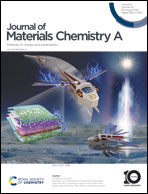2D transition metal-based phospho-chalcogenides and their applications in photocatalytic and electrocatalytic hydrogen evolution reactions
Abstract
The utilization of hydrogen (H2) as a renewable substitute for fossil fuel can mitigate issues related to energy shortage and associated global warming. The generation of H2via water splitting by photo and electrocatalytic means is of significant importance. The employment of a semiconductor catalyst reduces the high energy barrier (237 kJ mol−1) associated with a water-splitting reaction to yield H2 and O2. Sustainable H2 production demands the utilization of noble-metal-free, efficient, and stable catalysts over a wide pH range. In recent times, layered transition metal thio(seleno) phosphates (MPX3, X = S, Se) are reported to be highly efficient for H2 evolution reaction owing to their earth-abundance, rich active sites, wide spanned band gap of 1.2 to 3.5 eV, and high chemical stability. In this perspective, advances in 2D monometallic and bimetallic MPX3 compounds are reviewed comprehensively from the viewpoint of water splitting, especially the hydrogen evolution reaction (HER). This study includes the composition, structural engineering, heterostructure, and hierarchically structural design in enhancing the HER activity of MPX3. Computational results providing insights into the intrinsic photo and electrocatalytic HER activity of 2D MPX3 are presented. Finally, the challenges and opportunities in further improving MPX3 activity towards HER and associated catalysis reactions are discussed.

- This article is part of the themed collections: 1D/2D materials for energy, medicine, and devices and Journal of Materials Chemistry A Recent Review Articles


 Please wait while we load your content...
Please wait while we load your content...